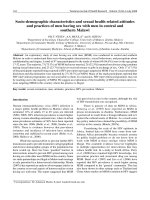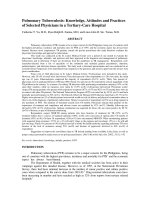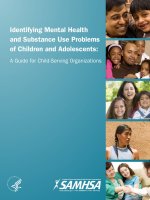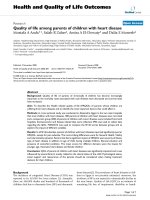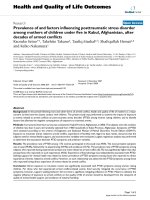Health related knowledge, attitudes and practices among parents of children aged 10 17 years, singapore
Bạn đang xem bản rút gọn của tài liệu. Xem và tải ngay bản đầy đủ của tài liệu tại đây (2.95 MB, 254 trang )
HEALTH-RELATED KNOWLEDGE, ATTITUDES AND
PRACTICES AMONG PARENTS OF CHILDREN
AGED 10-17 YEARS, SINGAPORE
ARASH POOYA
(MD, Community medicine specialty),
Isfahan University of Medical Sciences
A THESIS SUBMITTED
FOR THE DEGREE OF MASTER OF SCIENCE
DEPARTMENT OF
EPIDEMIOLOGY AND PUBLIC HEALTH
NATIONAL UNIVERSITY OF SINGAPORE
2010
Acknowledgement
Special thanks to my supervisor, Associate Professor Wong Mee Lian from whom I
learned a lot. I would like to express my appreciation to the “Agency for Science,
Technology and Research” (A*STAR) for awarding me the scholarship to complete
this Master‟s program.
My thanks also go to the “Health Promotion Board” (HPB) for funding this survey as
well as providing me with an opportunity to practice and learn more. Dr. Wong Mun
Loke and Ms. V Prema, from youth health division, are deeply appreciated for their
guidance through the survey.
I would also like to thank Dr. Amy Hu Yun (A/P Wong Mee Lian‟s research
assistant), and all my friends in department of Epidemiology and Public Health(EPH)
who helped me, in no small measure, in preparing this thesis.
I have no words to appreciate my beloved wife (Ladan) for all the emotional support
she has given me.
Last but not least; all parents and caregivers who participated in the survey are
appreciated for their kind help resulting in a better understanding of parental healthrelated knowledge, attitudes and practices regarding their adolescents, and will
hopefully result in improving the health of adolescents in Singapore.
ii
Table of contents
ACKNOWLEDGEMENT ........................................................................................... II
TABLE OF CONTENTS .......................................................................................... III
SUMMARY ................................................................................................................ XI
LIST OF TABLES .................................................................................................. XIV
LIST OF FIGURES ............................................................................................. XVIII
1 INTRODUCTION...................................................................................................... 1
1.1 BACKGROUND ........................................................................................................ 1
1.2 LITERATURE REVIEW .............................................................................................. 4
1.2.1 Parenting styles .............................................................................................. 5
1.2.2 Sexual health .................................................................................................. 9
1.2.3 Mental health ............................................................................................... 16
1.2.4 Smoking ........................................................................................................ 19
1.2.5 Diet ............................................................................................................... 25
1.2.6 Physical activity ........................................................................................... 30
1.2.7 Conclusion ................................................................................................... 33
2 AIMS AND OBJECTIVES ..................................................................................... 35
2.1 AIMS .................................................................................................................... 35
2.2 SPECIFIC OBJECTIVES ........................................................................................... 35
iii
3 METHODOLOGY .................................................................................................. 37
3.1 STUDY POPULATION ............................................................................................. 37
3.2 STUDY DESIGN ..................................................................................................... 37
3.3 SAMPLING METHOD .............................................................................................. 37
3.4 PILOT STUDY ........................................................................................................ 38
3.5 DATA COLLECTION ............................................................................................... 39
3.5.1 Interviewer-administered questionnaire ...................................................... 39
3.5.1.1 Socio-demographic questions ............................................................... 39
3.5.1.2 Life style behaviours ............................................................................. 40
3.5.1.3 Parenting styles ..................................................................................... 40
3.5.1.4 Diet ........................................................................................................ 42
3.5.1.5 Physical activity .................................................................................... 42
3.5.1.6 Smoking ................................................................................................ 43
3.5.1.7 Mental health ........................................................................................ 43
3.5.1.8 Sexual health ......................................................................................... 45
3.5.1.9 Health education sources ...................................................................... 46
3.5.2 Data collection process................................................................................ 47
3.5.2.1 Recruitment and training of interviewers ............................................. 47
3.5.2.2 Questionnaire reliability testing ............................................................ 47
3.5.2.3 Field work on data collection ................................................................ 54
3.6 REDUCING BIAS .................................................................................................... 57
3.7 ETHICAL CONSIDERATIONS .................................................................................. 58
3.8 DATA ANALYSIS ................................................................................................... 59
iv
4 RESULTS ................................................................................................................. 61
4.0 HOUSEHOLD INFORMATION BY DWELLING TYPE AND RESPONSE RATE ................ 61
4.1 SOCIO-DEMOGRAPHIC CHARACTERISTICS ............................................................. 66
4.2 OCCUPATIONS AND LIFESTYLE BEHAVIOURS OF CAREGIVERS AND THEIR SPOUSES
................................................................................................................................... 69
4.3 DIET ..................................................................................................................... 74
4.3.1 Caregivers’ knowledge on diet .................................................................... 74
4.3.1.1 Overall caregivers‟ knowledge on diet ................................................. 74
4.3.1.2 Caregivers‟ knowledge on diet by socio-demographic characteristics
and lifestyles ..................................................................................................... 76
4.3.2 Caregivers’ attitudes toward diet ................................................................ 81
4.3.3 Caregivers’ awareness of health promotion products or programs on diet 82
4.3.4 Caregivers’ practices on diet ....................................................................... 87
4.3.4.1 Caregivers‟ practices on diet ................................................................. 87
4.3.4.2 Caregivers correct dietary practice on fruits and vegetables by sociodemographic characteristics and lifestyles ........................................................ 90
4.3.4.3 Caregivers‟ unhealthy dietary practices by socio-demographic
characteristics and lifestyles ............................................................................. 94
4.3.4.4 Reasons for unhealthy dietary practices ............................................... 98
4.4. PHYSICAL ACTIVITY .......................................................................................... 100
4.4.1 Caregivers’ knowledge, attitudes and practices on physical activity ........ 100
4.4.2 Caregivers’ practices on physical activity by socio-demographic
characteristics ..................................................................................................... 102
v
4.4.3 Offer of electronic games by caregivers; socio-demographic characteristics
............................................................................................................................. 105
4.4.4 Caregivers’ attitudes towards smoking ..................................................... 107
4.4.4.1 Caregivers‟ attitude scores towards smoking ..................................... 107
4.4.4.2 Caregivers‟ attitude scores by socio-demographic characteristics ..... 108
4.5 MENTAL HEALTH ............................................................................................... 109
4.5.1 Communication between caregivers and adolescents ............................... 109
4.5.2 Caregivers’ attitudes towards adolescents’ mental health ........................ 110
4.5.3 Scores of caregivers’ attitudes towards adolescents’ mental health by sociodemographic characteristics ............................................................................... 113
4.5.4 Aspects of adolescents’ life which stress the caregivers ............................ 114
4.5.4.1 Aspects of adolescents‟ life which stress the caregivers by adolescents‟
age group ......................................................................................................... 114
4.5.4.2 Aspects of children‟s life which stress their caregivers by ethnicity .. 116
4.6 CAREGIVERS‟ COMMUNICATION AND PARENTING STYLE.................................... 117
4.6.1 Overall caregivers’ communication and parenting style........................... 117
4.6.2 Scores of caregivers’ communication and parenting style by ethnicity .... 120
4.6.3 Scores of caregivers’ communication and parenting styles by parents ..... 121
4.7 SEXUAL HEALTH COMMUNICATION .................................................................... 122
4.7.1 Caregivers’ attitudes towards sexual health.............................................. 122
4.7.1.1 Caregivers‟ attitude towards sex education in schools by sociodemographic characteristics ............................................................................ 122
4.7.1.2 Caregivers‟ attitude towards sex education in schools by sociodemographic characteristics and age groups................................................... 124
vi
4.7.1.3
Scores of caregivers‟ attitude towards sex education in schools by
ethnicity and educational level ........................................................................ 126
4.7.2 Caregivers’ attitude towards abstinence till marriage (pre-marital sex) .. 127
4.7.2.1 Caregivers attitude towards abstinence till marriage by sociodemographic characteristics ............................................................................ 127
4.7.2.2 Caregivers attitudes towards abstinence till marriage by sociodemographic characteristics, stratified by age groups .................................... 129
4.7.3 Caregivers’ attitudes towards consequences of engaging in sex before
marriage by socio-demographic characteristics ................................................ 130
4.7.4 Caregivers attitude towards contraception using condoms by sociodemographic characteristics ............................................................................... 132
4.7.5 Caregivers communicative ease regarding abstinence from sex till marriage
by socio-demographic characteristics ................................................................ 134
4.7.6 Caregivers’ communicative ease regarding sexual consequences ............ 135
4.7.6.1
Caregivers communicative ease regarding consequences of engaging
in sex before marriage by socio-demographic characteristics ........................ 135
4.7.6.2 Caregivers communicative ease regarding consequences of engaging in
sex before marriage by socio-demographic characteristics and by age groups
......................................................................................................................... 137
4.7.7 Caregivers’ communicative ease regarding contraception ....................... 139
4.7.7.1 Caregivers communication ease regarding contraception using
condoms by socio-demographic characteristics.............................................. 139
4.7.7.2 Caregivers communicative ease regarding contraception using condoms
by socio-demographic characteristics stratified by age groups ...................... 141
vii
4.7.8 Caregivers’ communication ease regarding protection from sexually
transmitted diseases ............................................................................................ 143
4.7.8. Caregivers communication ease regarding protection from disease using
condoms by socio-demographic characteristics.............................................. 143
4.7.8.2 Caregivers communication ease regarding protection from disease
using condoms by socio-demographic characteristics stratified by age groups
......................................................................................................................... 145
4.7.9 Caregivers’ confidence in sexual health communication .......................... 147
4.7.9.1 Caregivers confidence in answering questions regarding sexuality
issues by socio-demographic characteristics .................................................. 147
4.7.9.2 Caregivers confidence in answering questions regarding sexuality
issues by socio-demographic characteristics stratified by age groups ............ 148
4.7.10 Caregivers’ communication issues on sexual health ............................... 150
4.7.10.1 Scores of caregivers‟ perceived importance, comfort/ease and
confidence on sexual health communication .................................................. 150
4.7.10.2 Caregivers‟ perceived sexual health communication importance,
comfort/ease and confidence by socio-demographic characteristics .............. 152
4.7.10.3, Caregivers‟ discussion on sexual health issues by socio-demographic
characteristics .................................................................................................. 159
4.7.10.4. Caregivers‟ discussion on sexual health issues by socio-demographic
characteristics stratified by age groups ........................................................... 162
4.7.10.5 Spouses‟ discussion frequency on sexual health issues by sociodemographic characteristics (as reported by caregiver) .................................. 165
4.8 HEALTH EDUCATION SOURCES ........................................................................... 168
viii
4.8.1 Caregivers’ main & preferred health education sources .......................... 168
4.8.2 Caregiver’s main health education sources by socio-demographic
characteristics ..................................................................................................... 169
4.8.3 Caregiver’s preferred health education sources by socio-demographic
characteristics ..................................................................................................... 173
4.9 MULTIPLE LOGISTIC REGRESSION ....................................................................... 178
4.9.1 Caregivers’ communication with their adolescents about sexual health .. 178
4.9.2 Caregivers’ correct practice on serving vegetables and fruit to their
adolescents .......................................................................................................... 181
4.9.3 Caregivers’ practice on limiting the time their adolescents spend on TV and
video games ......................................................................................................... 185
5. DISCUSSION ........................................................................................................ 187
5.1 PRINCIPAL FINDINGS .......................................................................................... 187
5.2 STRENGTHS AND LIMITATIONS OF THE STUDY .................................................... 191
5.2.1 Strengths .................................................................................................... 191
5.2.2 Limitations ................................................................................................. 191
5.2.2.1 Study design ........................................................................................ 191
5.2.2.2 Interviewing process ........................................................................... 191
5.3 COMPARISON WITH OTHER STUDIES ................................................................... 192
5.3.1 Parenting styles .......................................................................................... 192
5.3.2 Sexual health .............................................................................................. 192
5.3.3 Mental health ............................................................................................. 193
5.3.4 Smoking ...................................................................................................... 194
ix
5.3.5 Nutrition ..................................................................................................... 194
5.3.6 Physical activity ......................................................................................... 195
5.4 CONCLUSIONS .................................................................................................... 196
5.5 RECOMMENDATIONS AND FUTURE RESEARCH .................................................... 198
5.5.1 Recommendations ...................................................................................... 198
5.5.1.1 Communication on sexuality issues .................................................... 198
5.5.1.2 Serving fruit and vegetables................................................................ 198
5.5.1.3 Limitation of sedentary activities........................................................ 199
5.5.1.4 Caregivers‟ health education sources .................................................. 199
5.5.2 Further research ........................................................................................ 200
REFERENCES .......................................................................................................... 202
APPENDIX 1 ................................................................................................................. I
APPENDIX 2 ........................................................................................................... XIV
APPENDIX 3 ........................................................................................................ XVIII
APPENDIX 4 ........................................................................................................... XIX
APPENDIX 5 ........................................................................................................... XXI
APPENDIX 6 .......................................................................................................... XXV
x
Summary of the Key Findings
Introduction
Parents play an important role in shaping the health-related behaviors of their children
through their practices, parenting styles, parental modeling and communication with
their children. This study assessed the health-related knowledge, attitudes and
practices among Singaporean or Singapore permanent resident parents pertaining to
the health of their children aged 10-17 years.
Methods
A nation-wide community based cross-sectional household survey was conducted on a
random sample of 1169 Singaporeans or Singapore permanent residents who were
parents or primary caregivers of adolescents aged 10 to 17 years. Participants who
resided in HDB households(78% of the households) were interviewed face-to-face
using a questionnaire on their socio-demographics, life style, health education sources
and parenting styles as well as their knowledge, attitudes and practices on their
adolescents‟ diet, physical activity, smoking issues, mental health and sexuality issues.
The same questionnaire was posted to private/condominium households (22% of the
households), because interviewers were not allowed to enter condominiums. The
overall individual response rate from eligible households was 81.4%.
xi
Results
One-third (32.4%) of the caregivers reported that they had never discussed sexuality
issues with their adolescents. Although caregivers reported a high mean score (8.0/10)
of perceived importance on communicating with their adolescents regarding sexuality
issues, they felt less comfortable and confident (mean scores: 6.3/10 and 6.2/10
respectively) in communicating with their adolescents in this area. One-third (33%) of
the respondents were aware that two servings of fruit and two servings of vegetables
should be served daily to adolescents, while a lower proportion (23.9%) practiced this.
Two-thirds (70.5%) and three-quarters (77.6%) of the parents limited the amount of
time their adolescents watched TV and played video games respectively, whilst onethird (34.4%) of the parents offered them electronic games as a reward for good
behavior.
Multiple logistic regressions showed a significant independent association between
caregivers‟ communication on sexuality issues (with their adolescents) and their
perceived importance (adjusted OR: 1.09 [95% CI: 1.03-1.16]) and comfort (adjusted
OR: 1.16 [95% CI: 1.07-1.25]) to communicate on sexuality. In addition the
caregivers‟ correct practice on giving two servings of fruits and vegetables to their
adolescents daily was associated with the caregivers‟ awareness of the correct portions
of daily fruits and vegetables servings for adolescents (adjusted OR: 3.42 [95% CI:
2.53-4.62]) and the caregivers‟ engaging in regular physical activity (adjusted OR:
1.54 [95% CI: 1.05-2.25]). In addition, in a multiple logistic regression model,
caregivers‟ limitation on their adolescents‟ sedentary activities (watching television
and playing video games) was found to be significantly associated with age of the
xii
adolescent(adjusted OR: 0.84 [95% CI: 0.79-0.89]) , and parenting style(adjusted
OR:1.01 [95% CI: 1.00-1.03]).
Conclusions
Parent-adolescent communication on sexuality was lacking among respondents with a
lack of parental perceived comfort and confidence being possible causes. In addition,
only a low proportion of the adolescents‟ parents reported adequate knowledge on
correct amounts of fruit and vegetables consumption and a lower proportion of parents
reported correct dietary behaviors accordingly. On the contrary, more than two-thirds
of the respondents limited the amount of time their adolescents watched TV and
played video games.
Recommendations
Improving parent-adolescent communication skills on sexuality issues through
community outreach workshops or activities can be an effective measure to improve
parent-adolescent communication in Singapore. Public education to parents on dietary
practices using a positive appeal may help improve parental dietary practices for their
adolescents.
xiii
List of Tables
Table 1.1 Selected studies on parenting styles ................................................................ 8
Table 1.2 Selected studies on adolescents‟ sexual health ............................................. 14
Table 1.3 Selected studies on mental health ................................................................. 18
Table 1.4 Selected studies on adolescents‟ smoking .................................................. 23
Table 1.5 Selected studies on Diet ................................................................................ 28
Table 1.6 Selected studies on Physical activity. ........................................................... 32
Table 3.1 Internal consistency for statements of parenting styles ................................ 41
Table 3.2 Mental health statements .............................................................................. 44
Table 3.3 Aspects of the adolescents‟ life which stresses the caregivers ..................... 44
Table 3.4 Caregivers‟ attitudes about communicating on sexuality issues with their
adolescents .................................................................................................................... 46
Table 3.5 Inter-rater reliability testing results for the caregivers‟ attitudes about
communicating with their adolescents‟ on sexual health. ............................................ 51
Table 3.6 Inter-rater reliability testing results for the caregivers‟ practice on sexuality
communication with their adolescents and attitude towards their adolescents‟
premarital sex. ............................................................................................................... 52
Table 3.7 Inter-rater reliability testing results for the caregivers‟ knowledge on serving
fruit and vegetables to their adolescents. ...................................................................... 52
Table 3.8 Inter-rater reliability testing results for the caregivers‟ attitudes towards
their adolescents smoking. ............................................................................................ 53
Table 3.9 Inter rater reliability testing results for the caregivers‟ parenting styles ..... 53
Table 4.1 Household Information by Housing Type .................................................... 63
Table 4.2 Relationship between housing type, race and gender of the interviewed
household member and response. ................................................................................. 65
Table 4.3 Socio-demographic characteristics of the caregivers in households .......... 67
Table 4.4 Occupations and lifestyle behaviours of caregivers and their spouses. ........ 70
xiv
Table 4.5 Smoking and alcohol drinking status of the adolescents .............................. 71
Table 4.6 Association between caregivers‟ and spouses‟ life-style practices and their
engagement in physical activity with their adolescents ................................................ 73
Table 4.7 Caregivers‟ knowledge on diet for their adolescents .................................... 75
Table 4.8 Caregivers‟ knowledge on diet by socio-demographic characteristics and
lifestyles ........................................................................................................................ 78
Table 4.9 Caregivers‟ attitudes toward diet .................................................................. 81
Table 4.10 Caregivers‟ awareness of food logo, food pyramid and model school tuckshop program by socio-demographic characteristics and lifestyles .............................. 84
Table 4.11 Caregivers‟ practices on diet....................................................................... 88
Table 4.12 Caregivers‟ correct dietary practice by socio-demographic characteristics
and lifestyles ................................................................................................................. 91
Table 4.13 Caregivers‟ unhealthy dietary practices by socio-demographic
characteristics and lifestyles ......................................................................................... 95
Table 4.14 Caregivers‟ knowledge and practices on their adolescents‟ physical activity
..................................................................................................................................... 101
Table 4.15 Caregivers‟ practices regarding children‟s sedentary activities by sociodemographic characteristics ........................................................................................ 103
Table 4.16 Distribution of caregivers who offered electronic games to their child by
socio-demographic characteristics .............................................................................. 105
Table 4.17 Caregivers‟ attitude scores towards their adolescents‟ smoking .............. 107
Table 4.18 Caregivers‟ attitude scores towards smoking by socio-demographic
characteristics .............................................................................................................. 108
Table 4.19 Caregivers‟ attitude scores towards their adolescents‟ mental health ...... 111
Table 4.20 Caregivers‟ mental health attitude scores regarding their adolescents ..... 112
Table 4.21 Caregivers‟ total mental health attitude score by socio-demographic
characteristics .............................................................................................................. 113
Table 4.22 Caregivers‟ stress level regarding adolescent‟s affairs ............................. 114
Table 4.23 Caregivers‟ communication and parenting styles ..................................... 118
Table 4.24 Scores of caregivers‟ communication and parenting style by ethnicity ... 120
xv
Table 4.25 Scores of caregivers‟ communication and parenting style by parent ..... 121
Table 4.26 Caregivers‟ attitude towards sex education in the schools by
sociodemographic characteristics ........................................................................................ 123
Table 4.27 Caregivers‟ attitude towards sex education in the schools by sociodemographic characteristics stratified by age groups ................................................. 125
Table 4.28 Scores of caregivers‟ sex education attitude¹ by ethnicity and educational
level ............................................................................................................................. 126
Table 4.29
Caregivers‟ attitude towards abstaining from sex till marriage by sociodemographic characteristics ........................................................................................ 128
Table 4.30
Caregivers‟ attitudes towards abstaining from sex till marriage by
socio-demographic characteristics stratified by age groups ....................................... 129
Table 4.31 Caregivers‟ attitudes towards importance of communicating with their
adolescents on consequences of engaging in sex before marriage by sociodemographic characteristics ........................................................................................ 131
Table 4.32 Caregivers‟ attitudes towards importance of talking to their adolescents on
using condoms for contraception by socio-demographic characteristics.................... 133
Table 4.33 Caregivers‟ ease for communicating with their adolescents regarding
abstinence from sex till marriage by socio-demographic characteristics ................... 134
Table 4.34 Caregivers‟ ease for communicating with their adolescents regarding
consequences of engaging in sex before marriage by socio-demographic characteristics
..................................................................................................................................... 136
Table 4.35 Caregivers‟ ease for communicating with their adolescents regarding
consequences of engaging in sex before marriage by socio-demographic characteristics
stratified by age groups ............................................................................................... 138
Table 4.36 Caregivers‟ ease for communicating with their adolescents regarding using
condoms for contraception by socio-demographic characteristics ............................. 140
Table 4.37 Caregivers‟ ease for communicating with their adolescents regarding using
condoms for contraception by socio-demographic characteristics and by age groups
..................................................................................................................................... 142
Table 4.38 Caregivers‟ ease for communicating with their adolescents regarding using
condoms to protection from disease by socio-demographic characteristics ............... 144
Table 4.39 Caregivers‟ ease for communicating with their adolescents regarding using
condoms to protect from disease by socio-demographic characteristics and by age
groups .......................................................................................................................... 146
xvi
Table 4.40 Caregivers‟ confidence in answering their adolescents‟ questions regarding
sexuality issues by socio-demographic characteristics ............................................... 147
Table 4.41 Caregivers‟ confidence in answering child‟s questions regarding sexuality
issues by socio-demographic characteristics and by age groups ................................ 149
Table 4.42 Scores of caregivers‟ perceived importance, comfort/ease and confidence
on sexual health communication ................................................................................. 151
Table 4.43 Caregivers‟ perceived sexual health communication importance,
comfort/ease and confidence by socio-demographic characteristics .......................... 153
Table 4.44 Caregivers‟ discussion on sexual health issues with the child by sociodemographic characteristics ........................................................................................ 160
Table 4.45 Caregivers‟ discussion on sexual health issues with their children by sociodemographic characteristics stratified by age groups ................................................. 163
Table 4.46 Spouses‟ discussion on sexual health issues with their children by sociodemographic characteristics (reported by the caregivers) .......................................... 166
Table 4.47 Caregiver‟s main health education sources by socio-demographic
characteristics .............................................................................................................. 170
Table 4.48 Caregivers‟ preferred health education sources by socio-demographic
characteristics .............................................................................................................. 174
Table 4.49 Statistically significant adjusted odds ratios of caregiver-adolescent
sexuality communication by caregivers‟ perceived importance and confidence towards
sexuality communication with their adolescents (Multiple logistic regressions) ....... 181
Table 4.50 Statistically significant adjusted odds ratios of caregiver-adolescent
sexuality communication by caregivers‟ perceived importance and comfort towards
sexuality communication with their adolescents (Multiple logistic regressions) ....... 182
Table 4.51 Statistically significant adjusted odds ratios of caregivers‟ correct dietary
practice on serving fruit and vegetables to their adolescents as a function of caregivers‟
knowledge on this issue and their practice on physical activity (Multiple logistic
regressions) ................................................................................................................. 184
Table 4.52 Statistically significant adjusted odds ratios of caregivers‟ limitation on
their adolescents for sedentary activities by socio-economic status, life-style and
parenting-style of the caregivers (Multiple logistic regressions) ................................ 186
xvii
List of Figures
Fig 3.1 Flowchart of data collection from HDB households ........................................ 55
Fig 4.1 Distribution of responding households by housing type in surveyed sample .. 64
Fig 4.2 Distribution of households in the general population ....................................... 64
Fig 4.3 Reasons for serving instant noodles to the adolescent daily by caregivers ..... 99
Fig 4.4 Reasons for not giving fruits or vegetables to the child daily .......................... 99
Fig 4.5 Communication between caregivers and adolescents .................................... 109
Fig 4.6 Aspects of adolescents' life that stress the caregivers by age groups ............. 115
Fig 4.7 Aspects of adolescents' life that stress their caregivers by ethnicity .............. 116
Fig 4.8 Sexual health communication attitudes of caregivers stratified by their practice
..................................................................................................................................... 156
Fig 4.9 Caregivers‟ attitudes (importance and comfort) towards communicating with
their adolescents regarding different sexuality issues ................................................. 157
Fig 4.10 Caregivers‟ attitudes towards communicating with their children about ..... 158
Fig 4.11 Caregivers‟ main and preferred health education sources ............................ 168
Fig 4.12 Main health education sources for caregivers from 1-2 room HDB flats .... 176
Fig 4.13 Preferred health education sources for caregivers from 1-2 room HDB flats
..................................................................................................................................... 177
xviii
1 Introduction
1.1 Background
According to the World Health Organization, adolescence is defined as the age group
from 10-19 years of age. As this group is a heterogeneous group, this interval is
divided into three phases including “Early”, “Middle” and “Late” adolescence. In the
early phase, adolescents experience puberty, rapid physical growth and a raised
interest in their self image. In the middle phase an adolescent may practice potentially
risky behaviors such as unprotected sexual intercourse and use psychoactive
substances including both legal and illegal ones. Although many of these behaviors
may not persist for a long time, some consequences of these behaviors can be lifelong- such as HIV infection as a result of unprotected sex. Finally, late adolescence is
a phase in which adolescents may prefer to form more stable relationships and achieve
long-term perspectives. This is a developmental pathway to early adulthood (Detels
2009).
Despite great differences in the scope and severity of health problems among youth in
different continents and countries, a similar profile of problems and burdens can be
found around the world. These problems include malnutrition, violence (self inflicted
or to others), HIV/sexually transmitted infections (STIs) /unplanned pregnancies,
substance abuse, mental health problems and social problems due to chronic
conditions (Detels 2009).
1
Health habits acquired during adolescence will make an impact on health status in the
future and eventually on the global burden of disease. According to Lopez and
Mathers (2006), at least five items among the top ten conditions that affect global
burden of disease are directly associated with health behaviors mainly developed
during adolescence; these behaviors include unsafe sex, psychoactive substances or
tobacco use (legal or illegal), physical inactivity and high body mass index(BMI)
(Lopez and Mathers 2006).
Health-related behaviors and attitudes of adolescents may be shaped and affected by
different factors. Among these factors, Parents play an important role in shaping the
health-related behaviors of their children through their practices, parenting styles or
parental modeling. When addressing adolescent‟s health related behaviors, the main
categories to be considered include diet, physical activity, mental health, smoking and
sexual health. Much research has shown that if parents inculcate in their offspring
healthy habits regarding smoking and diet, these habits continue into their adulthood
(Astrom 1998; O'Callaghan, O'Callaghan et al. 2006; Fidler, West et al. 2008). Thus,
assessing parents‟ attitudes and behaviors regarding health and their communication
with their children in this regard might be of crucial importance in the promotion of
children‟s health related attitudes and behaviors.
This study is a part of a nation-wide survey in Singapore on parental perceptions,
attitudes, and practices of various health domains on children aged 4-17 years. Two
questionnaires were used in the survey; one for parents of children aged 4-9 years, and
the other for parents of adolescents aged 10-17 years. Findings on the knowledge,
2
attitudes and practices among parents of children from the ages of 10-17 are reported
in this thesis.
3
1.2 Literature review
Since our study aims to assess parental knowledge, attitudes and practices pertaining
to their adolescent children‟s health domains in Singapore, this literature review will
be written according to the following health domains which were studied among
caregivers of children from the ages of 10-17 years:
1. Parenting styles
2. Sexual health
3. Mental health
4. Smoking
5. Diet
6. Physical activity
4
1.2.1 Parenting styles
It has been established that family plays an important role throughout adolescence,
thus making the parent-adolescent relationship very important and influential on an
adolescent‟s behavior (Marta 1997).
While earlier studies used a typological approach to classify parents on their parenting
styles (authoritative, authoritarian, permissive and neglectful), recent studies rely on
two independent factors called “Responsiveness” and “Demandingness” (Cox 2007).
“Responsiveness refers to parental attention to children‟s needs by encouraging
individuality, self regulation and self assertion” whereas “demandingness” reflects the
means by which parents integrate their children into the family system by promoting
maturity, discipline, supervision and appropriate confrontation for disobedience” (Cox
2007).
Authoritative parents are those who show a high level of responsiveness and
demandingness, whilst those who are highly demanding and show a low level of
responsiveness are classified as authoritarian parents. Permissive parents seem to be
highly responsive and non-demanding, whereas rejecting-neglecting parents seem to
show none of the responsiveness and demandingness characteristics (Cox 2007).
A review article by DeVore & Ginsburg )2005) shows the effects of parenting
practices on an adolescent‟s development and risk behaviors. Parental monitoring is
defined as a combination of supervision and communication between parents and
children. There are conflicting studies on whether direct control over an adolescent‟s
behavior results in optimum consequences or not. Extensive research has indicated
5
that authoritative parenting, parental monitoring and supervision positively affect the
development of an adolescent (DeVore and Ginsburg 2005).
Similar findings in another study on 16,749 adolescents(2004), support that greater
self-esteem and lower risk behaviors among adolescents might be related to high
parental support and parental monitoring (Parker and Benson 2004).
Literature does not support the idea that authoritative parenting is the best parenting
style for all communities. Evidence from Spanish families published in 2009 indicates
that the indulgent (permissive) parenting style is probably the most effective parenting
style in Spain .The authoritative parenting style follows, and is reported to be better
than the authoritarian and neglectful styles. The classification of parents into different
parenting styles has been conducted according to the data collected from their
teenagers and the not parents themselves. This might explain the difference between
the results of this study and other studies in which authoritative parenting style is
reported to be the best style (Garcia and Gracia 2009).
Adolescents who reported having indulgent or neglectful parents were older in age
compared to those who reported their parents to be authoritative or authoritarian in a
study conducted among 1771 Dutch teenagers aged 16-17 years, and published in
2003. Adolescents who were religious seemingly showed a higher prevalence of
reporting authoritative or authoritarian styles, while indulgent or neglectful parenting
styles were reported more among non-religious adolescents. The authoritative and
neglectful parenting styles seemed to be more often reported by girls and boys
respectively (Kremers, Brug et al. 2003).
6
Research suggests that parenting styles might work differently in different health
domains. Much research supports the association between parenting styles and
adolescents‟ sexual behavior, adolescents‟ smoking and physical activity, with
authoritative parenting style increasing sexual abstinence and also protective behaviors
on smoking and physical activity (Radziszewska, Richardson et al. 1996; Chassin,
Presson et al. 2005; Arredondo, Elder et al. 2006; Cox 2007; Choquet, Hassler et al.
2008). Although adolescents dietary habits seem to be associated with parenting styles
according to some studies (Kremers, Brug et al. 2003; Arredondo, Elder et al. 2006),
such an association with general parenting style is not supported in a study conducted
by Vericken et al. in 2003 among 1614 pairs of sixth graders and their parents in
Belgium; while food related parenting practice (encouragement through negotiation)
showed a positive association with children‟s dietary habits which might be explained
by the age range of the children in this study (Vereecken, Legiest et al. 2009). A
review article by Newman et al.(2008) on studies published from 1996-2007, suggests
that parenting style may probably influence adolescent development (Newman,
Harrison et al. 2008).
7

